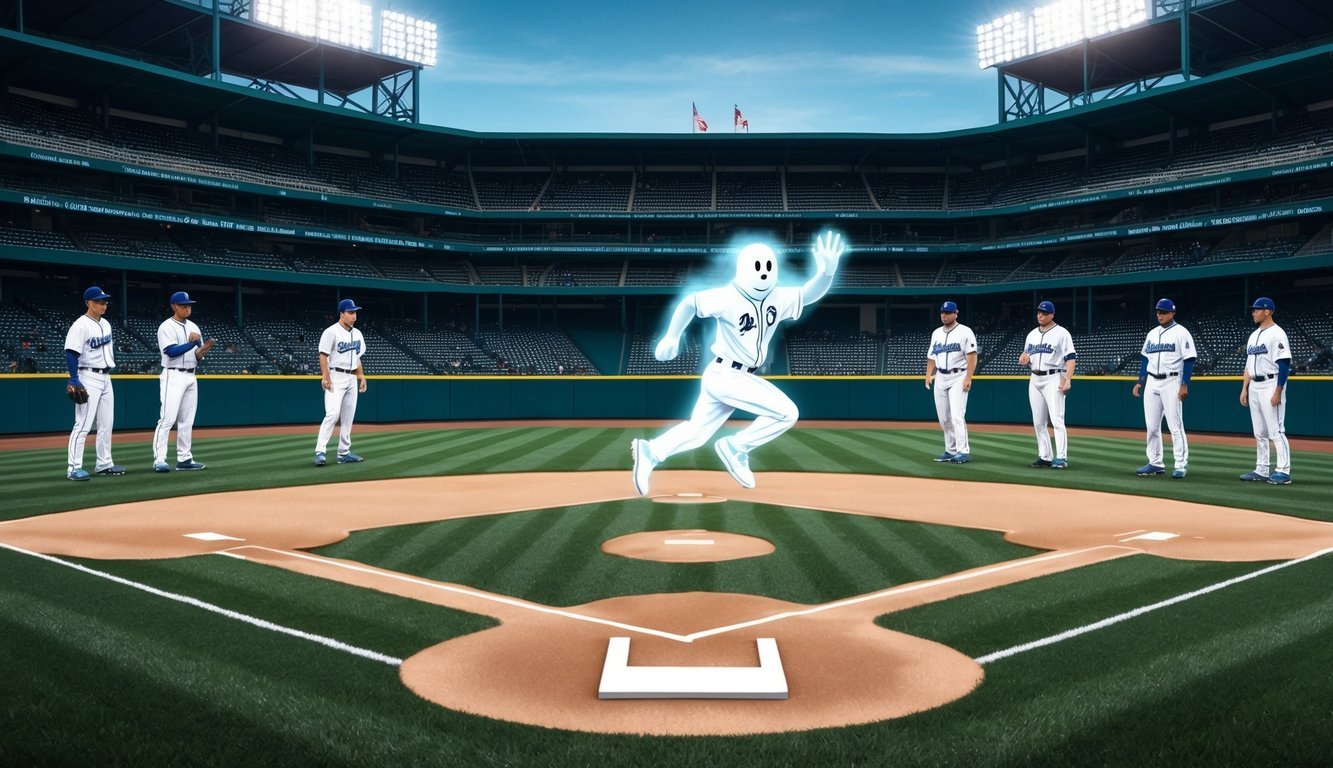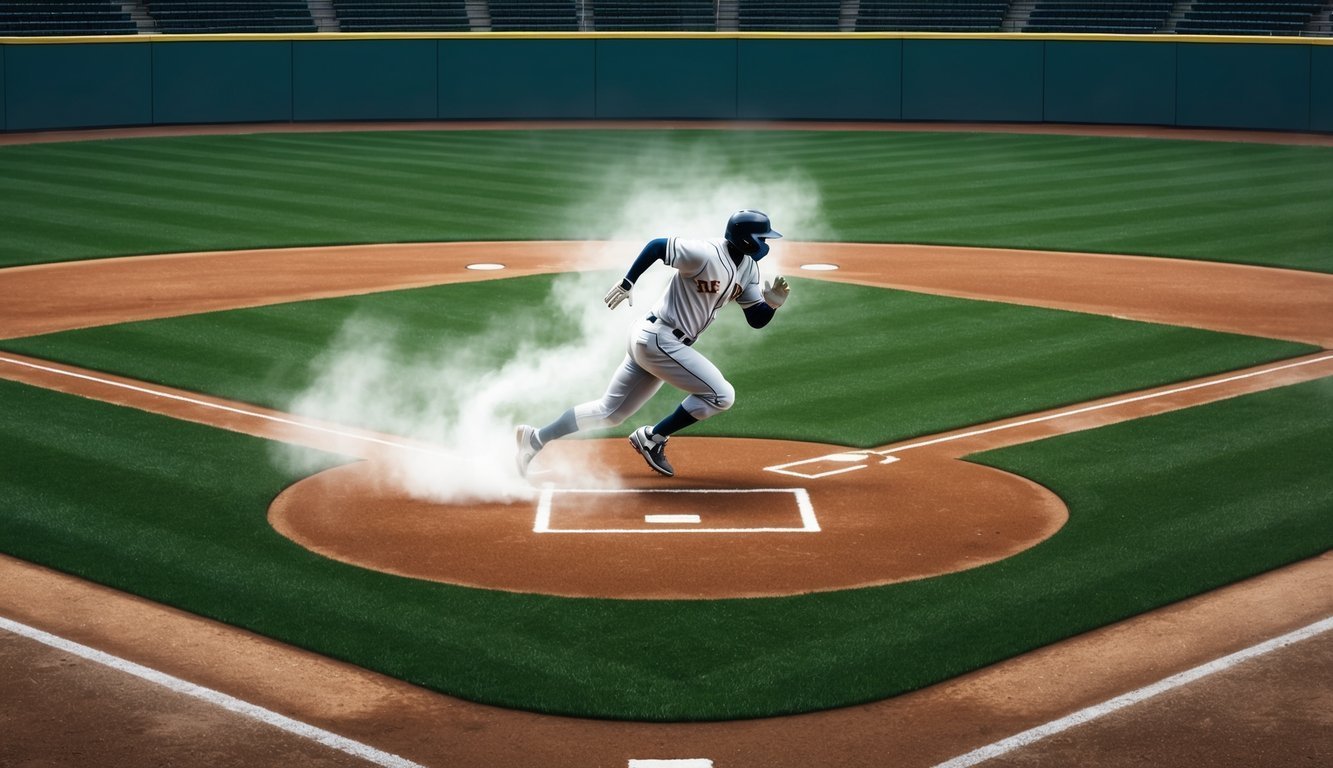Baseball fans have witnessed a significant change to extra innings in recent years.
The “ghost runner” rule has become a permanent fixture in Major League Baseball.
This rule places a runner on second base at the start of each half-inning during extra innings, aiming to increase scoring opportunities and shorten game times.
The ghost runner has sparked debate among players, managers, and fans alike.
Some appreciate the added excitement and strategy it brings to extra innings, while others feel it strays too far from baseball tradition.
Regardless of personal opinions, the rule has undeniably altered the way teams approach late-game situations.
As the 2024 MLB season unfolds, players and coaches continue to adapt their strategies to maximize the ghost runner’s impact.
From sacrifice bunts to intentional walks, the rule has introduced new tactical considerations that keep fans on the edge of their seats during extra-inning thrillers.
Understanding the Ghost Runner Rule
The ghost runner rule adds excitement to extra innings in MLB games.
It aims to speed up play and increase scoring opportunities in late-game situations.
Concept of the Extra Inning
Extra innings occur when a baseball game is tied after nine innings.
Traditionally, teams would continue playing full innings until one team scored more runs.
This could lead to marathon games lasting many hours.
The ghost runner concept changes this dynamic.
It places a runner on second base to start each extra inning.
This runner represents the batter who made the last out in the previous inning.
By having a runner in scoring position immediately, the rule creates instant tension.
It increases the chances of scoring and ending the game more quickly.
Implementing the Ghost Runner in MLB
MLB introduced the ghost runner rule in the 2020 season.
It was part of changes made during the shortened season due to the COVID-19 pandemic.
The rule proved popular and remained in place for the 2021 and 2022 seasons.
In 2023, MLB made it a permanent feature of regular season games.
Here’s how it works:
- Starts in the 10th inning
- Applies to both home and away teams
- Runner placed on second base
- No cost to the batting team
The ghost runner rule doesn’t apply in postseason games.
MLB wanted to preserve the traditional format for its most important contests.
Impact of the Ghost Runner Rule on Gameplay

The Ghost Runner Rule has significantly altered baseball strategy and game dynamics.
Teams, pitchers, and managers have adapted their approaches to leverage or counteract this rule change.
Strategy Adjustments for Teams
Teams now prioritize situational hitting in extra innings.
Managers often instruct batters to bunt or hit to the right side, aiming to advance the ghost runner to third base.
This emphasis on small ball tactics has led to more sacrifice plays and hit-and-run attempts.
Defensive alignments have also shifted.
Infielders play closer to home plate to prevent bunts, while outfielders position themselves to cut off potential scoring plays.
Base-running has become more aggressive.
Teams are more likely to send runners home on shallow fly balls, knowing the importance of each run in extra innings.
Pitchers and Pitching Dynamics
Pitchers face increased pressure with a runner automatically on second base.
They must work from the stretch immediately, affecting their rhythm and pitch selection.
Breaking balls and off-speed pitches are used more frequently to induce ground balls and strikeouts.
Pitchers aim to keep the ball on the infield to prevent the ghost runner from scoring easily.
Intentional walks have become more common, especially with one out.
Pitchers may choose to set up a double play opportunity or face a weaker hitter.
Influence on the Pace of Games
The Ghost Runner Rule has successfully reduced the length of extra-inning games.
Games are less likely to extend deep into extra innings, as scoring becomes more probable with a runner on second.
Action-packed innings are more frequent, with teams actively trying to score or prevent runs from the start of each extra frame.
This increased tension and excitement has been well-received by many fans.
However, some purists argue that the rule diminishes the strategic depth of traditional extra-inning play.
They feel the natural ebb and flow of longer games has been replaced by a more artificial and immediate pressure situation.
Reactions from the Baseball Community
The ghost runner rule has sparked diverse opinions across the baseball world, with managers, players, and fans expressing varying views on its impact and place in the game.
Managers’ Perspectives on the Rule
Many managers have adapted their strategies to accommodate the ghost runner rule.
Los Angeles Dodgers skipper Dave Roberts embraces the change, noting it adds excitement to extra innings.
Diamondbacks manager Torey Lovullo sees it as a tactical challenge, often opting for small-ball approaches to advance the runner.
Some managers prefer the traditional format, arguing that the rule alters the fundamental nature of the game.
They believe it puts undue pressure on pitchers and diminishes the importance of bullpen depth.
Players’ Views and Adaptations
Pitchers and position players have had to adjust their approaches in extra innings.
Many hurlers find the rule challenging, as they must immediately face a scoring threat.
Some have developed specialized strategies for these high-pressure situations.
Position players, especially those with strong bunting skills, have seen their value increase in extra innings.
Speedsters on the basepaths have become crucial assets for the offensive team.
Several players appreciate the rule for reducing marathon games and the associated physical toll.
Baseball Purists and Fan Opinions
Traditional baseball fans often criticize the ghost runner rule as an artificial way to end games.
They argue it diminishes the strategic depth of extra innings and rewards teams for a single well-placed hit rather than sustained offensive prowess.
Some fans, however, enjoy the added excitement and quicker resolutions to games.
They find the rule creates more dramatic moments and increases fan engagement during extra innings.
Joint Competition Committee and Rule Evolution

MLB’s Joint Competition Committee plays a crucial role in shaping baseball’s rules.
This group of players, team representatives, and an umpire has made significant decisions to adapt the game for modern times.
The Committee’s Role in Rule Changes
The Joint Competition Committee consists of 11 members, including six team representatives, four player representatives, and one umpire.
This diverse group works together to evaluate and implement rule changes in Major League Baseball.
In recent years, they’ve tackled issues like the “ghost runner” rule and restrictions on position players pitching.
Their decisions aim to improve game pace, player safety, and overall fan experience.
Adaptations to Baseball Regulations
The committee has made several key adaptations to baseball regulations.
They voted to make the automatic runner rule permanent for extra innings in regular-season games.
This change, initially introduced in 2020, places a runner on second base at the start of each extra inning.
The committee also addressed the use of position players as pitchers, setting limitations to preserve the integrity of the game.
These adaptations reflect a balance between tradition and innovation in baseball.
The committee considers factors like game length, player workload, and fan engagement when making decisions.
Their work ensures that baseball evolves while maintaining its core appeal.
Looking Ahead: The Ghost Runner’s Future

The ghost runner rule has become a fixture in MLB, but its future remains a topic of ongoing discussion.
Changes and adjustments may be on the horizon as the league continues to evaluate its impact on gameplay.
Potential for Permanent Integration in MLB
The ghost runner rule has gained traction since its introduction.
MLB officially made it permanent for regular season games in February 2023.
Teams have adapted their strategies, with many embracing the rule’s potential for quick resolutions in extra innings.
Clubs are likely to refine their approaches in the upcoming season.
Managers may prioritize players with specific skills for extra-inning situations.
Speed and contact hitting could become more valuable for roster construction.
The rule’s impact on postseason games remains a point of debate.
Some argue that playoff contests should maintain traditional extra-inning formats, while others believe consistency across regular season and playoffs is ideal.
Prospects for Rule Amendments
MLB continues to monitor the ghost runner’s effects.
Minor tweaks to the rule could emerge in future seasons.
One potential change is adjusting when the runner is placed on base.
Some suggest starting with a ghost runner from the 11th or 12th inning instead of the 10th.
This adjustment could preserve the integrity of the game while still encouraging more dynamic gameplay in extra innings.
It would allow teams a fair chance to strategize without feeling the pressure of an immediate scoring opportunity.
Additionally, teaching players how to slide in baseball effectively becomes even more crucial as teams look to capitalize on the new rules, emphasizing both skill and tactics in their approach to scoring runs in critical moments.
Player safety concerns may influence future amendments.
Reduced playing time in extra innings could lower injury risks.
This aspect might factor into discussions between MLB and the players’ union.
The league may also consider input from fans and media.
USA Today and ESPN polls have shown mixed reactions to the rule.
Fan sentiment could sway decision-makers as they evaluate long-term plans for extra innings.
